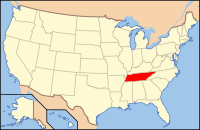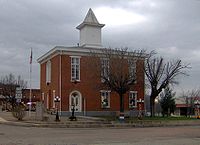- Clay County, Tennessee
-
Clay County, Tennessee Clay County Courthouse in Celina, Tennessee
Location in the state of Tennessee
Tennessee's location in the U.S.Founded 1870 Seat Celina Largest city Celina Area
- Total
- Land
- Water
259 sq mi (671 km²)
236 sq mi (612 km²)
23 sq mi (60 km²), 8.93%Population
- (2010)
- Density
7,861
34/sq mi (13/km²)Time zone Central: UTC-6/-5 Clay County is a county located in the U.S. state of Tennessee. Its name is in honor of American statesman Henry Clay, member of the United States Senate from Kentucky and United States Secretary of State in the 19th century. As of the census[1] of 2010, there were 7,861 people residing in the county. Its county seat and the only incorporated city in the county is Celina[2].
Contents
Geography
According to the U.S. Census Bureau, the county has a total area of 259 square miles (670.8 km2), of which 236 square miles (611.2 km2) is land and 23 square miles (59.6 km2) (8.93%) is water. The Cumberland River flows through the center of the county from north to south, fed by the Obey River which flows through the city of Celina from its impoundment at the Dale Hollow Reservoir. The reservoir, known as Dale Hollow Lake, inundates much of the eastern part of the county.
Adjacent counties
- Monroe County, Kentucky (north)
- Cumberland County, Kentucky (northeast)
- Pickett County (east)
- Overton County (southeast)
- Jackson County (south)
- Macon County (west)
Demographics
As of the census[1] of 2000, there were 7,976 people, 3,379 households, and 2,331 families residing in the county. The 2005 Census Estimate placed the population at 7,992 [1]. The population density was 34 people per square mile (13/km²). There were 3,959 housing units at an average density of 17 per square mile (6/km²). The racial makeup of the county was 96.75% White, 1.44% Black or African American, 0.33% Native American, 0.14% Asian, 0.11% Pacific Islander, 0.24% from other races, and 0.99% from two or more races. 1.35% of the population were Hispanic or Latino of any race.
There were 3,379 households out of which 27.70% had children under the age of 18 living with them, 54.70% were married couples living together, 9.70% had a female householder with no husband present, and 31.00% were non-families. 27.60% of all households were made up of individuals and 12.00% had someone living alone who was 65 years of age or older. The average household size was 2.33 and the average family size was 2.80.
In the county, the population was spread out with 21.50% under the age of 18, 7.90% from 18 to 24, 27.40% from 25 to 44, 27.60% from 45 to 64, and 15.70% who were 65 years of age or older. The median age was 40 years. For every 100 females there were 94.60 males. For every 100 females age 18 and over, there were 95.00 males.
The median income for a household in the county was $23,958, and the median income for a family was $29,784. Males had a median income of $23,513 versus $16,219 for females. The per capita income for the county was $13,320. About 14.30% of families and 19.10% of the population were below the poverty line, including 23.40% of those under age 18 and 27.60% of those age 65 or over.
History
Clay County was formed in 1870 by combining pieces from surrounding Jackson County and Overton County. Cordell Hull's first law office— now a museum— was located in Clay County.
Clay county's early inhabitants farmed and worked the Cumberland River transportation center, which was the major way to get around the Cumberland area. There were many docks and ferry crossings throughout Clay county to get local crops and livestock to major markets. The timber industry was a large player throughout the 1800s and 1900s and still provides many jobs today. Tobacco farming became an important crop in the local area throughout the 1900s and many old tobacco barns are still standing. With the end of government subsidies and foreign competition, tobacco farming has decreased to minuscule participation. Cattle and corn are the major agricultural influences today.
During the Civil War, many skirmishes took place up and down the Cumberland River to control the movement of barges laden with supplies. Local communities were split in their loyalties, with many families at odds with each other. Some of these animosities remain today between family groups.
The city of Celina is at the junction of the Obey and Cumberland rivers, and was a major port during the steamboat years between Nashville and Burnside, Kentucky. Although the Celina ferry landing no longer exists, Celina still connects the north and south by highway. Butler's Landing was used as a storage depot with large warehouses owned and operated by the Butler family. The first Clay County Court meeting was held in a store near the river at Butler's Landing on March 6, 1871. Butler's Landing nearly became the county seat, but Celina won the vote by a thin margin.
Clay County's rural location and lack of major four-lane highway connections continues to hamper development and recruitment of businesses. This has resulted in the county having the highest unemployment rating in the State of Tennessee many months of the year and the loss of educated young people who have no opportunities locally.
Lincoln connection
Hananiah Lincoln (1756 to 1814) is buried in a cemetery near Tinsley Bottom in Clay County. He is the half second cousin of President Abraham Lincoln. Hananiah's first born son was named Thomas Lincoln (1780 to 1844). President Lincoln's father was also a Thomas Lincoln(1778 to 1851). As a result of the two Thomas Lincolns living in Kentucky over a 25-year period between 1789 and 1814, area residents in both Tennessee and Kentucky often confuse Hananiah's son as the Father of President Lincoln and Hananiah Lincoln as the paternal Grandfather of President Lincoln. On Route 53 in Clay County there is a Tennessee Historical Marker perpetuating the falsehood of Hananiah Lincoln as the paternal Grandfather of President Abraham Lincoln. Hananiah and his son lived in Cumberland County, Kentucky in the Meshack Creek area. In 1799, Martha Gee and Hananiah's son, Thomas Lincoln were married in Cumberland County, Kentucky. President Abraham Lincoln's Father, Thomas Lincoln married Nancy Hanks in 1806 in Washington County, Kentucky. Part of present day Clay County was once the southern most area of Cumberland County, Kentucky.[citation needed]
Populated places
- Celina (the only incorporated municipality in the county)
- Arcot Community
- Beech Bethany Community
- Brimstone Community
- Butler's Landing Community
- Denton Crossroads Community
- Free Hill
- Hamilton Branch Community
- Hermitage Springs Community
- Lily Dale Community
- Maple Grove Community
- Moss Community
- Neely Crossroads Community
- Oak Grove
- Pea Ridge community
- Pine Branch/ Kettle Creek Community
- Shanky Branch Community
See also
References
- ^ a b "American FactFinder". United States Census Bureau. http://factfinder.census.gov. Retrieved 2008-01-31.
- ^ "Find a County". National Association of Counties. http://www.naco.org/Counties/Pages/FindACounty.aspx. Retrieved 2011-06-07.
- ^ Based on 2000 census data
External links
- Official Chamber of Commerce website
- Official Clay County Tourism Board website
- Clay County at the Open Directory Project
- Dale Hollow HORIZON local newspaper website

Monroe County, Kentucky Cumberland County, Kentucky 
Macon County 
Pickett County  Clay County, Tennessee
Clay County, Tennessee 

Jackson County Overton County Municipalities and communities of Clay County, Tennessee City Unincorporated
communityCategories:- Tennessee counties
- Clay County, Tennessee
- 1870 establishments
Wikimedia Foundation. 2010.


